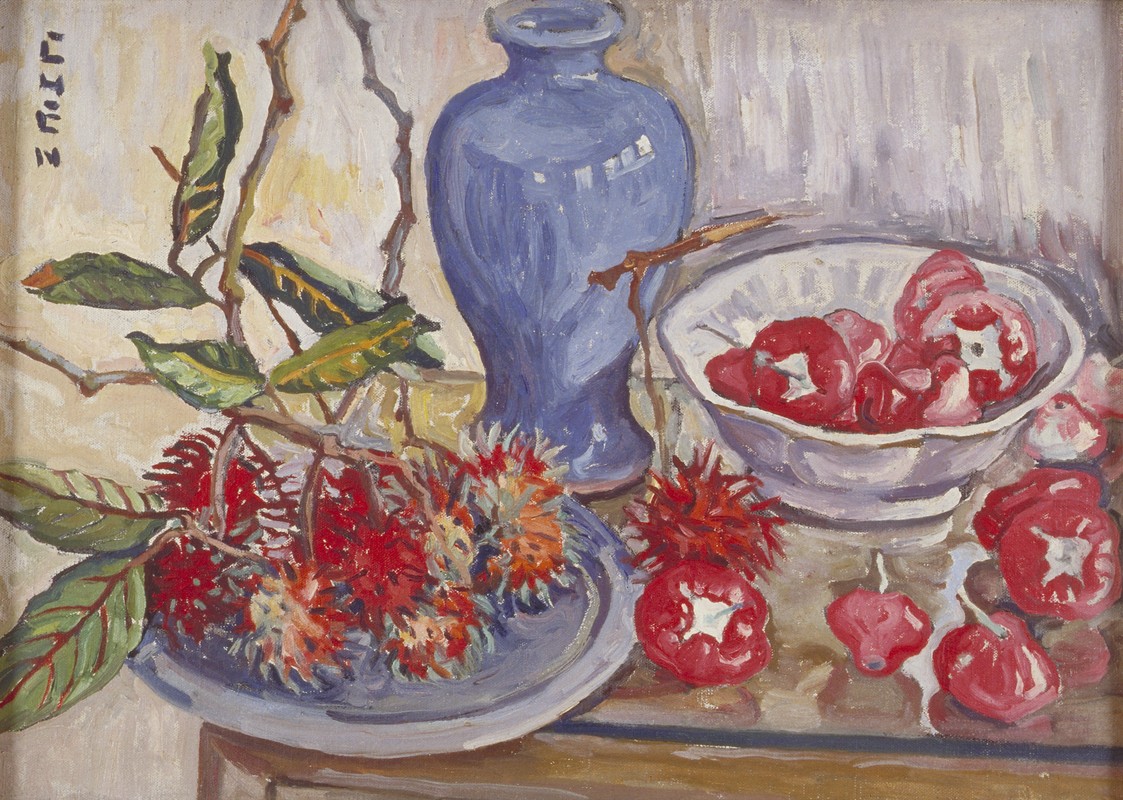“中华美术”在新加坡
若把“中华美术”视为“华族文化”组成的部分,两者都是无法轻易界定的术语。那么,“中华美术”在新加坡的语境中,究竟意味着什么?从这个角度而言,“中华美术”可以是一种绘画风格、一种艺术形式或脉络、一套美学价值和特性,或任何出自华族艺术家之手的创作;它也可以是新加坡现代美术史上,紧扣“南洋风(格)”这个同样广受讨论之术语的一种叙事;抑或指向一个“诠释社群”(interpretive community)——此社群关注“中华美术”的不同显像,指的是一个以论述和审美为主的社群。
在新加坡的多元文化背景下,要厘清这其中的各种关联与定义,极其困难。但无疑有其必要。为“中华美术”释义,一方面得以中国美学史、风格流派、水墨画,以及绘画与书法、文学、工艺和哲学的关系等“核心元素”来建构其定义;另一方面则得通过审视以下课题,解构这些核心元素:20世纪的社会和文化变革、现代性、与语言和地理(以新加坡为中心)的关系,以及作为东南亚文化变革、生活体验和文化产物背景的“南洋”。
刘抗的中华美术观
获誉为新加坡先驱画家之一的刘抗(1911-2004),其思想内容之复杂,或可为如何定义中华美术提供重要启示。刘抗出生于中国福建,成长于马来亚,后回返中国上海接受美术教育。17岁毕业后,他留学巴黎,22岁时回到上海出任西洋画教授。随着第二次中日战争(1937-1945)爆发,他于1937年再度踏足马来亚和新加坡,时年26岁。此后的70多年间,刘抗成为新加坡美术界的重要人物,其著作、创作和传记涉及范围广泛,其中包括公共讨论、教育、社区领导、社会参与等。

本文将引用刘抗1981年出版并亲自写序的《刘抗文集》1,和新加坡国家美术馆于2011年出版的英译增订版,来讨论他著作中的两个主题:其一是借评价20世纪主要的美术运动和艺术家,概述艺术之现代性;再来是以文化和集体框架(华人、多元文化)阐述美术的宗旨和功能。
不少1940年代到1980年代间出版的美术史论述,都强调在第二次世界大战结束后,新加坡艺术开始展现国家主义。从刘抗的文字也可看出这方面的转变。然而,其中一些有关美术和美学、更为根本的议题,因欠缺合适的术语而与本质主义和民族主义挂上了钩,“现代中国人”就是其中一例(见下文1948年之引文)。对“中华美术”课题而言,这点十分值得关注。无论是“中国人”作为一种身份,还是刻板的多元文化主义,依附与前就某个集体框架,结果就是丧失美术和美学应有的更宽广的历史深度。
刘抗曾就开拓立体主义的毕加索(1881-1973)和上海画派画家黄宾虹(1865-1955)这两位20世纪美术界的杰出人物,先后做出以下介绍:
“……演着主观渗入于对象中,潜移默化,由穿透而进至破坏对象,使解散而为片片的元素,再把这等断片组合起来,构成新的自我形态。”(1948年)
“宾虹至于南洋,并不如悲鸿之被普遍认识,就算是认识,是否能透彻了解,乃是疑问,事实上,他的艺术造诣,已集古今各家之大成,创造独特的风格,很可能成为我国绘画史上的绝唱。”(1955年)
相比之下,刘抗对徐悲鸿(1895-1953)的艺术评价较低:“悲鸿的艺术,是以写实主义为基干,无论中西画,都很注重形似,要达致形似,就得有纯熟的技巧,结果把技巧排在艺术的第一位,甚至时代意识,民族风格,就沦为次要的了。”(1967年)

刘抗对毕加索和黄宾虹的看法,是支撑他在传统和创新的范畴内,探索如何通过美术,动态地表达时代精神的基础。然而,说到民族风格,就不免涉及棘手的(族群、公民、文化)民族/集体主义。刘抗谈到了美术的更高或根本目的,但表达时却得借用民族/集体主义的框架,实为遗憾:
“……我们体验到所遭遇的是什样的社会……我们更知道什么是准确的目标和正大的道路,撇开许多细节不谈,我们所想创造的是:能表现出“现代中国人”的艺术。”(1948年)
“……有了文化交流,精神的慰籍和性灵的陶冶,始有其凭据,而整个人类才有物质生活之外的更高理想境界的实现。”(1950年)
事实上,刘抗大部分的著作,都对新加坡迈向多元文化和国家主义的转型给予积极评价。他于1960年和1969年分别说道:
“……我们也有值得自豪之感,因为享用着多元民族的文化,从而采取了独特的创作路线……”(1960年)
“……艺术的感应力虽然超乎国界,但在意境与造型方面则变化无穷……新加坡是个新兴独立国……以聚集的民族而言,则其文化背景不但根源繁复丰富、而且历史有远至数千年者……我们的文化传统,不但是包涵各民族的,而且是横跨东西两个世界的。”(1969年)
刘抗自认笔下众多文章,可构成一份记述新加坡艺术与文化的历史档案,而事实确是如此。他在1981年出版的《刘抗文集》自序中这么写道:
“……其中好些内容都牵涉到我国近半世纪推动艺术的情况及创作动向。若把它当作是我国的一部分历史文献,也未尝不可。”(1981年)
以油画媒介为主的刘抗,偶有水墨作品,他对书法也有所涉猎。对于一位20世纪的艺术家而言,艺术必然是跨文化的,这一点从他阐明结合东西方等多元文化来源和灵感之必要性的论点,可见一斑。故事说到这里,似乎已可画上句号,正如刘抗于其1960年代之后的文章中,在某种程度上预示的那般。他后期的著作并未尝试从更高层次上去谈论美术,缺乏了他口中所言“精神的慰藉和性灵的陶冶“以及“整个人类才有物质生活之外的更高理想境界的实现”。身为一名重要的美术界领袖,刘抗似乎更多地投入了本地美术组织和管理方面的工作。
新加坡国家美术馆于2011年出版的《刘抗:文集新编》,将刘抗的文章按时间先后顺序,以不同主题重新编排,并加入丘小嘉撰写的书籍和章节介绍。丘小嘉认为,刘抗的油画应可视为中华美术,因为“刘氏于1950年代创作的作品,以粗细不一的粗线条勾勒人物和物体,意在仿效中国文人画的某种笔触”。2
丘小嘉也进一步指出,刘抗的绘画“特点在于利用留白、线条、风格化的画风……来表现质感和动感”,并且视文人画为画家内心自省的外在流露。丘小嘉还补充说,刘抗的西为中用,是借用了欧洲的美术理念,来创造现代中华美术。3
以上这些评语都是正面的,不过丘小嘉同时也明确指出“刘氏从未打算创造一门国家美术,而是专注于将传统中国画现代化”。4由于丘小嘉并未说明何谓“国家美术”,不知他文中指刘抗借用欧洲美术理念,是否意味“国家美术”应完全以此为前提?难道中华美术和新加坡其他族群的传统文化,不应该是所谓“国家美术”的源泉吗?
何谓“国家美术”
2023年12月5日,尚达曼总统在王赓武教授的《与众文明共存》新书发布会上致辞时说:“王教授强调……中华文明和不断演变的当代中国民族文化是有区别的”。总统接着补充说,“印度文明和不断演变的当代印度文化也一样,伊斯兰文明亦同。这些形塑了我们的古文明会持续发挥影响力,但我们须把古文明中历久不衰的理念和价值观,与当代民族文化及其相关习性区分开来。”5
这一点与中华美术在新加坡的讨论息息相关,因为所谓的美术,甚或“国家美术”,其基础正是建立于历史渊源悠久的中华美术,和其他如来自印度或伊斯兰的美学渊源之上。无论是灵感来源或表现方式,这其中的历史跨度都不应局限于20世纪国家主义兴起后的那几十年。而认识到艺术家的美学资源必得和集体主义的形式分隔开来,更为重要。比如说,中华文化须与“当代中国民族文化”,甚至是多元文化主义脱钩,除非这对艺术家而言是具成效的运作模式。文化渊源、集体主义和多元文化主义,在美术实践中实分属不同层面。
著名美术史学家巫鸿在其著作中就曾点出,中国绘画有完全不同于西方绘画传统的一些重要特征。6在西方美术中,“风景画”要到16世纪时才成为一个独立的美术门类,中国的“山水画”则比西方的风景画早了一千多年。所以解读山水画不宜用西方美术观点。水墨山水首先是超越感官体验的,既不追求精确捕捉眼前所见,画的也不是特定或具体的风景,而是着重呈现一个包含形而上学、概念化了的地理布局。到了11世纪,巨幅墨色山水的观画体验更近一步融合多重视点、远近距离和时间性,让画中山水超脱人之感官而兀自存在。7
中国画对时空有着截然不同的理解,手卷画尤是如此。按巫鸿的说法:“我们虽然可以把它想象为古代的电影或电视,但是电影和电视的播放速度不由观者操纵,因此与手卷画仍有本质上的区别。”8
王赓武教授所言之“中华文明”(Sinic civilisation),或许包含了中华文化和中华美术。他视中华文化为恒古不变的,这和巫鸿的观点则有所不同。巫鸿则认为,中华美术,尤其是在全球美术史的背景下,实际上不断产生变化:“中国美术的内容和概念必然是不断变化的;对它的性格和语言的识别,也就是在千变万化的美术形式和内容及其社会环境中寻找变化的动因和恒久的因素。”9
从上述不同角度看中华文明、中华文化、中华美术,或许存在时间范围上的差距,但就美术实践而言,无论强调的是永恒不变或瞬息万变,需要的都是丰富、有一定时间跨度的历史作为参考和资源。这正是刘抗试图做的事情。
所谓“南洋风(格)”
尚达曼总统在致辞中也指出,新加坡在本区域是独一无二的,因为占新加坡人口多数的华人社群,长期以来一直是东南亚的少数群体。10本文对中华美术在新加坡的讨论,并非以华人作为多数群体为主,而是关注如何更全面地理解这段与大批包括刘抗在内的南来艺术家有着密切关系的本地美术发展史。这批艺术家不仅大力推动、实践和教授美术,其文化现代性的传承,与五四运动、上海现代美术教育,以及中华美术作为美学泉源和价值的理念一脉相承。这批艺术及的作品和思想,在美术史学者如姚梦桐、沙峇巴地等人的著作中被概括为“南洋风(格)”,是本地美术史的重要课题。
南洋风(格)并不是新加坡美术的唯一论述。尚达曼总统所提及,身为多数族群但始终具备少数族群的自觉,并深知族群敏感性的这一心态,实际上与全面了解新加坡美术发展所需的方法论相呼应。并且,在思考新加坡“中华美术”和“华族文化”这两个具挑战性的概念时,这一方法应时时具备“外部性”(exteriorities)的框架、去中心化,并打破既定分类的局限。
本文原文为 What ‘Chinese art’ means in Singapore,此为编辑和翻译后的版本。点击此处查看原文。
| 1 | 刘抗,《刘抗文集》;萧佩仪主编,《刘抗:文集新编》。 |
| 2 | 萧佩仪主编,《刘抗:文集新编》,页52。 |
| 3 | 同上,页11-12。 |
| 4 | 同上,页100。 |
| 5 | Transcript of Speech by President Tharman Shanmugaratnam at IPS-Nathan Lecture Series – 12th Fellow, Professor Wang Gungwu ‘Living with Civilisations’ Book Launch, President’s Office, 5 December 2023. |
| 6 | 巫鸿,《全球景观中的中国古代艺术》。 |
| 7 | 同上。 |
| 8 | 同上,页152。 |
| 9 | 同上,页5。 |
| 10 | Transcript of Speech by President Tharman Shanmugaratnam at IPS-Nathan Lecture Series – 12th Fellow, Professor Wang Gungwu ‘Living with Civilisations’ Book Launch, President’s Office, 5 December 2023. |
刘抗,《刘抗文集》。新加坡:教育出版社,1981。 | |
巫鸿,《全球景观中的中国古代艺术》。北京:三联书店,2017。 | |
萧佩仪主编,《刘抗:文集新编》。新加坡:新加坡国家美术馆,2011。 |










